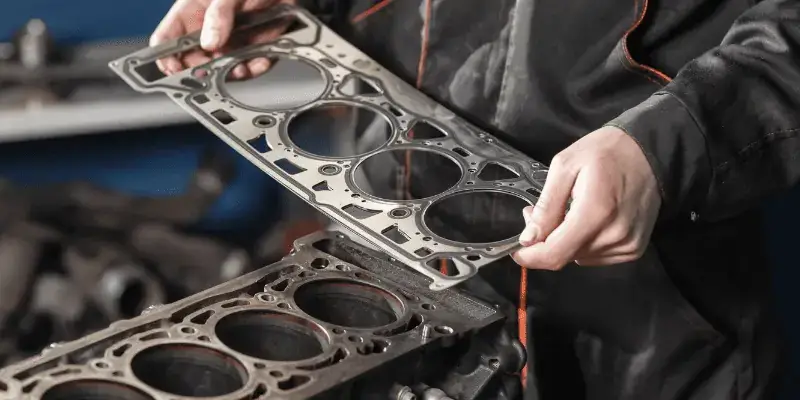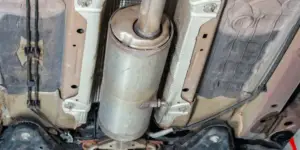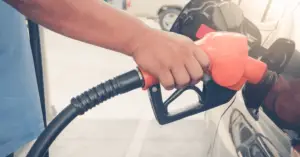Coolant is a very important fluid. The engine produces a lot of heat, and the coolant absorbs that heat and takes it away from the engine to have it cooled down by the radiator.
Modern car engines have a feature that whenever there is low coolant or when the car is overheating, it won’t let the car start until the coolant temperature is optimal. Therefore modern cars shouldn’t shake when the coolant is low. Normally you can just add coolant so that the coolant level is up to the mark and crank the car to see if it starts.
Older cars don’t have this feature and might not start when the coolant level is too low.
Sometimes the car manages to start even with low coolant, and you will notice a little car shake after it does.
A faulty radiator cap is the most common and may cause an overflow or seepage of engine coolant.
4 Related Causes of Shaking and Low Coolant
Let’s look in more detail:
Blown Head Gasket
A blown head gasket can be why you have low coolant and your car is shaking. A water pump pumps the coolant in a closed loop to prevent contamination of the coolant and the combustion chamber.
If your head gasket is blown, the engine coolant could leak into the combustion chamber, mixing with the oil and the petrol and reducing power production during combustion. This lack of power causes a drop in RPMs, and the engine struggles to cause car shakes.
By checking the exhaust fumes, you can know for sure if your car has a bad head gasket. Coolant leaks usually create white fumes seen in the exhaust gases.
Fuel inefficiency and white fumes paired together signify a blown head gasket. To compensate for this lack of power, the air control valve allows more air into the combustion chamber, resulting in more fuel being injected and poor fuel economy.

You will also notice a change in coolant color since the oil and fuel get mixed into the coolant and circulate through the system. A burning sweet smell may also be apparent from under the hood; this is the ethylene glycol burning off.
Repairs
Repairs require a change of head gasket. It is possible that the head gasket was blown due to a poor gasket. It is better to bring the car to an auto repair shop because changing a head gasket requires technical knowledge, and any shortcomings in installing a new head gasket might become faulty. A head gasket replacement will cost upwards of $500.
Pistons and Combustion Chamber
Car shaking and low engine coolant can also signal that the coolant is leaking into the engine’s combustion chamber in large quantities. Since the engine coolant cannot be compressed, it causes an increase in engine pressure causing the piston and connecting rods to become warped or bent.
The ECU may sense the lack of power and make the air control valve drive in more air and fuel to compensate for the lack of power. Even after you have a head gasket changed, the damaged piston and the parts connected to it might still be damaged and cause a rough idle or RPM drops, causing car shakes.
A rattling in the engine and poor fuel economy, and sometimes exhaust fumes have a smell of slightly burnt fuel. This happens because the piston rings and the piston are out of place, reducing compression.
Repairs
An auto car repair shop might be a good idea in this situation because you would need the engine to be opened and every part inspected. A complete engine overhaul would cost around $1500-$2500, depending on the problem and the make and model of the car.
Water Pump
A water pump is responsible for pumping the coolant throughout your engine. The crankshaft drives the water pump. If the water pumped becomes jammed or damaged, the crankshaft sometimes struggles; as a result, causing car shakes as the engine struggles to run smoothly.
A small piston inside the water pump sometimes gets damaged due to low or leaking engine coolant. The piston is designed to pump air and coolant. Any contamination or stress on the pump may damage parts, causing it to malfunction and vibrate.

Whenever there is a problem with the water pump, the engine usually gives a check engine light, or you will see a rise in the temperature gauge sensed by the coolant temperature sensor.
Even if the temperature sensor is not working properly, you can always connect a diagnostic tool in the OBD port of the ECU, and it will show the error code for a drop in coolant pressure.
If you have an old car, you might notice a burning rubber smell, as the belt that drives the water pump might be struggling to power the pump.
Repairs
It is best recommended to get a new water pump instead of having the old one fixed. You can probably change it yourself if you can locate it in the hood and configure it properly.
The water pump can cost you around $150-$300. If you plan on having it changed by a car shop, it will set you back around $550.
Coolant Sensor Malfunction
Coolant system sensors ensure the correct temperature for the engine isn’t exceeded. These sensors work in coordination to ensure that the car runs however you want it to without overheating.
If any of these sensors malfunction, which they can do for several reasons, it would cause car shakes or rough idle.
There is a coolant temperature sensor that works the water pump and the cooling fans depending on the readings recorded by it.
If the coolant temperature sensor malfunctions and tells the ECU that your car is at, or below, optimum temperature, then that might cause the engine to heat up and start heating the coolant.
This heated coolant isn’t able to regulate engine temperatures, so the excess heat prematurely ignites the fuel rather than the spark igniting it at the required moments and creates a knocking noise.
This results in car shakes. An engine coolant level sensor also senses the coolant level falling and may trigger a coolant warning light.
If a bad coolant temperature sensor is in the loop, this won’t inform you of low coolant and may cause the engine to heat up with you unaware. The excess heat again causes the engine to knock and the car to shake.
A sensor malfunction usually results in a blinking check engine light and high-temperature readings. You can plug the diagnostic tool into the OBD port to check for error codes causing the check engine light.
Repairs
Repairs usually include having the sensors changed. Each sensor will cost around $35, and changing them would cost $60 with labor.
Conclusion
Low coolant can cause shakes but not directly. Low coolant impacts other things, which causes the car to shake. If you want to check there is very low coolant, turn on your heater since that works using the heat of the coolant.
It is better to check the coolant level now and then because it directly reflects on the driving conditions and the health of your engine.
If there is a problem with your car, then your coolant level might be able to help you in catching it early. Have your coolant checked and replaced if required.
Sometimes a faulty radiator cap can cause the coolant to overflow, or a head gasket leak can cause the coolant level to go down.
Faulty radiator caps are one of the most common problems, so always have that checked first. If the radiator cap seems fine, then go on to check signs of a head gasket leak.












